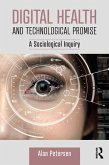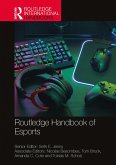46,95 €
46,95 €
inkl. MwSt.
Sofort per Download lieferbar

23 °P sammeln
46,95 €
Als Download kaufen

46,95 €
inkl. MwSt.
Sofort per Download lieferbar

23 °P sammeln
Jetzt verschenken
Alle Infos zum eBook verschenken
46,95 €
inkl. MwSt.
Sofort per Download lieferbar
Alle Infos zum eBook verschenken

23 °P sammeln
- Format: PDF
- Merkliste
- Auf die Merkliste
- Bewerten Bewerten
- Teilen
- Produkt teilen
- Produkterinnerung
- Produkterinnerung

Bitte loggen Sie sich zunächst in Ihr Kundenkonto ein oder registrieren Sie sich bei
bücher.de, um das eBook-Abo tolino select nutzen zu können.
Hier können Sie sich einloggen
Hier können Sie sich einloggen
Sie sind bereits eingeloggt. Klicken Sie auf 2. tolino select Abo, um fortzufahren.

Bitte loggen Sie sich zunächst in Ihr Kundenkonto ein oder registrieren Sie sich bei bücher.de, um das eBook-Abo tolino select nutzen zu können.
This critical social science monograph examines direct-to-consumer genetic testing. Focusing on disease testing, it asks, what new social arrangements emerge when a traditionally clinical practice (genetic testing) is taken into new spaces (the internet).
- Geräte: PC
- mit Kopierschutz
- eBook Hilfe
- Größe: 2.14MB
Andere Kunden interessierten sich auch für
![CyberGenetics (eBook, ePUB) CyberGenetics (eBook, ePUB)]() Anna HarrisCyberGenetics (eBook, ePUB)48,95 €
Anna HarrisCyberGenetics (eBook, ePUB)48,95 €![Digital Health and Technological Promise (eBook, PDF) Digital Health and Technological Promise (eBook, PDF)]() Alan PetersenDigital Health and Technological Promise (eBook, PDF)41,95 €
Alan PetersenDigital Health and Technological Promise (eBook, PDF)41,95 €![Death and Digital Media (eBook, PDF) Death and Digital Media (eBook, PDF)]() Michael ArnoldDeath and Digital Media (eBook, PDF)41,95 €
Michael ArnoldDeath and Digital Media (eBook, PDF)41,95 €![Routledge Handbook of Esports (eBook, PDF) Routledge Handbook of Esports (eBook, PDF)]() Routledge Handbook of Esports (eBook, PDF)45,95 €
Routledge Handbook of Esports (eBook, PDF)45,95 €![The Biopolitics of Gender in Science Fiction (eBook, PDF) The Biopolitics of Gender in Science Fiction (eBook, PDF)]() Emily Cox-Palmer-WhiteThe Biopolitics of Gender in Science Fiction (eBook, PDF)43,95 €
Emily Cox-Palmer-WhiteThe Biopolitics of Gender in Science Fiction (eBook, PDF)43,95 €![We, Other Utopians (eBook, PDF) We, Other Utopians (eBook, PDF)]() Eva SlesingerováWe, Other Utopians (eBook, PDF)43,95 €
Eva SlesingerováWe, Other Utopians (eBook, PDF)43,95 €![Memetic War (eBook, PDF) Memetic War (eBook, PDF)]() Tine MunkMemetic War (eBook, PDF)20,95 €
Tine MunkMemetic War (eBook, PDF)20,95 €-
-
-
This critical social science monograph examines direct-to-consumer genetic testing. Focusing on disease testing, it asks, what new social arrangements emerge when a traditionally clinical practice (genetic testing) is taken into new spaces (the internet).
Dieser Download kann aus rechtlichen Gründen nur mit Rechnungsadresse in A, B, BG, CY, CZ, D, DK, EW, E, FIN, F, GR, HR, H, IRL, I, LT, L, LR, M, NL, PL, P, R, S, SLO, SK ausgeliefert werden.
Produktdetails
- Produktdetails
- Verlag: Taylor & Francis eBooks
- Seitenzahl: 176
- Erscheinungstermin: 28. April 2016
- Englisch
- ISBN-13: 9781317368182
- Artikelnr.: 44979824
- Verlag: Taylor & Francis eBooks
- Seitenzahl: 176
- Erscheinungstermin: 28. April 2016
- Englisch
- ISBN-13: 9781317368182
- Artikelnr.: 44979824
- Herstellerkennzeichnung Die Herstellerinformationen sind derzeit nicht verfügbar.
Anna Harris completed a medical degree at the University of Tasmania, and a Masters and PhD in Medical Anthropology at the University of Melbourne. She has been a post-doctoral researcher at the Universities of Maastricht and Exeter. She has published in clinical and social science journals, and her own blog.
Susan Kelly is Associate Professor in Sociology, University of Exeter and Senior Research Fellow in Egenis (Exeter Centre for the Study of the Life Sciences). She earned a PhD in Sociology from the University of California, San Francisco, followed by a post-doctoral position in the Stanford Center for Biomedical Ethics.
Sally Wyatt is Programme Leader of the e-Humanities Group of the Royal Netherlands Academy of Arts and Sciences, and Professor of Digital Cultures in Development at Maastricht University. She is the founding co-editor (with Andrew Webster) of the Health, Technology & Society series published by Palgrave Macmillan.
Susan Kelly is Associate Professor in Sociology, University of Exeter and Senior Research Fellow in Egenis (Exeter Centre for the Study of the Life Sciences). She earned a PhD in Sociology from the University of California, San Francisco, followed by a post-doctoral position in the Stanford Center for Biomedical Ethics.
Sally Wyatt is Programme Leader of the e-Humanities Group of the Royal Netherlands Academy of Arts and Sciences, and Professor of Digital Cultures in Development at Maastricht University. She is the founding co-editor (with Andrew Webster) of the Health, Technology & Society series published by Palgrave Macmillan.
1. Introduction: CyberGenetics 1.1. Brief history of direct-to-consumer
genetic testing 1.2. Brief history of the internet and health online 1.3.
Intersecting determinisms: When genetic testing goes online 1.4. New spaces
for health-e relations? 1.5. Changing relations of trust, in bodies,
expertise, science, technology 1.6. Overview of book 1.7. Apple falls from
the tree 2. Users 2.1. Patients-in-waiting 2.2. Celebrity users 2.3.
Non-celebrity users 2.4. Potential users and non-users 2.5. Conclusion 3.
Professionals 3.1. Genetic counselling online: Co-production of users and
technologies 3.2. Representations of genetic counselling by DTC genetic
testing companies 3.3. Models of genetic counselling provision 3.4. Genetic
counselling roles 3.5. New roles for genetic counselors 3.6. Conclusion 4.
Participation 4.1. The participatory turn? 4.2. Novel methods: The
'research-y' part of 23andMe 4.3. 23andMe's 'participatory culture' 4.4.
Sharing gifts under the genetic family tree 4.5. Reciprocal ties 4.6.
Spitting for free 4.7. Conclusion 5. Controversy 5.1. Schizophrenia
genetics 5.2. Controversy goes online 5.3. Selling genetic tests online for
schizophrenia 5.4. Controversy in action: Citation and production of
knowledge 5.5. Conclusion 6. Conclusion: CyberGenetic futures 6.1.
Preventive Measures 6.2. Letters from the lake 6.3. GenULuv announces entry
to stock market 6.4. Online Genetic Testing: An archaeological assessment
Appendix A: New media, new genetics, new methods A.1. Methodological
choices made in preparation of this book A.2. Finding material online:
Ethics of using self-reported data A.3. Ontological issues of finding
participants and defining 'users' A.4. The internet is not the world:
Epistemological considerations of online research A.5. Future directions
Appendix B: List of DTC genetic testing websites
genetic testing 1.2. Brief history of the internet and health online 1.3.
Intersecting determinisms: When genetic testing goes online 1.4. New spaces
for health-e relations? 1.5. Changing relations of trust, in bodies,
expertise, science, technology 1.6. Overview of book 1.7. Apple falls from
the tree 2. Users 2.1. Patients-in-waiting 2.2. Celebrity users 2.3.
Non-celebrity users 2.4. Potential users and non-users 2.5. Conclusion 3.
Professionals 3.1. Genetic counselling online: Co-production of users and
technologies 3.2. Representations of genetic counselling by DTC genetic
testing companies 3.3. Models of genetic counselling provision 3.4. Genetic
counselling roles 3.5. New roles for genetic counselors 3.6. Conclusion 4.
Participation 4.1. The participatory turn? 4.2. Novel methods: The
'research-y' part of 23andMe 4.3. 23andMe's 'participatory culture' 4.4.
Sharing gifts under the genetic family tree 4.5. Reciprocal ties 4.6.
Spitting for free 4.7. Conclusion 5. Controversy 5.1. Schizophrenia
genetics 5.2. Controversy goes online 5.3. Selling genetic tests online for
schizophrenia 5.4. Controversy in action: Citation and production of
knowledge 5.5. Conclusion 6. Conclusion: CyberGenetic futures 6.1.
Preventive Measures 6.2. Letters from the lake 6.3. GenULuv announces entry
to stock market 6.4. Online Genetic Testing: An archaeological assessment
Appendix A: New media, new genetics, new methods A.1. Methodological
choices made in preparation of this book A.2. Finding material online:
Ethics of using self-reported data A.3. Ontological issues of finding
participants and defining 'users' A.4. The internet is not the world:
Epistemological considerations of online research A.5. Future directions
Appendix B: List of DTC genetic testing websites
1. Introduction: CyberGenetics 1.1. Brief history of direct-to-consumer
genetic testing 1.2. Brief history of the internet and health online 1.3.
Intersecting determinisms: When genetic testing goes online 1.4. New spaces
for health-e relations? 1.5. Changing relations of trust, in bodies,
expertise, science, technology 1.6. Overview of book 1.7. Apple falls from
the tree 2. Users 2.1. Patients-in-waiting 2.2. Celebrity users 2.3.
Non-celebrity users 2.4. Potential users and non-users 2.5. Conclusion 3.
Professionals 3.1. Genetic counselling online: Co-production of users and
technologies 3.2. Representations of genetic counselling by DTC genetic
testing companies 3.3. Models of genetic counselling provision 3.4. Genetic
counselling roles 3.5. New roles for genetic counselors 3.6. Conclusion 4.
Participation 4.1. The participatory turn? 4.2. Novel methods: The
'research-y' part of 23andMe 4.3. 23andMe's 'participatory culture' 4.4.
Sharing gifts under the genetic family tree 4.5. Reciprocal ties 4.6.
Spitting for free 4.7. Conclusion 5. Controversy 5.1. Schizophrenia
genetics 5.2. Controversy goes online 5.3. Selling genetic tests online for
schizophrenia 5.4. Controversy in action: Citation and production of
knowledge 5.5. Conclusion 6. Conclusion: CyberGenetic futures 6.1.
Preventive Measures 6.2. Letters from the lake 6.3. GenULuv announces entry
to stock market 6.4. Online Genetic Testing: An archaeological assessment
Appendix A: New media, new genetics, new methods A.1. Methodological
choices made in preparation of this book A.2. Finding material online:
Ethics of using self-reported data A.3. Ontological issues of finding
participants and defining 'users' A.4. The internet is not the world:
Epistemological considerations of online research A.5. Future directions
Appendix B: List of DTC genetic testing websites
genetic testing 1.2. Brief history of the internet and health online 1.3.
Intersecting determinisms: When genetic testing goes online 1.4. New spaces
for health-e relations? 1.5. Changing relations of trust, in bodies,
expertise, science, technology 1.6. Overview of book 1.7. Apple falls from
the tree 2. Users 2.1. Patients-in-waiting 2.2. Celebrity users 2.3.
Non-celebrity users 2.4. Potential users and non-users 2.5. Conclusion 3.
Professionals 3.1. Genetic counselling online: Co-production of users and
technologies 3.2. Representations of genetic counselling by DTC genetic
testing companies 3.3. Models of genetic counselling provision 3.4. Genetic
counselling roles 3.5. New roles for genetic counselors 3.6. Conclusion 4.
Participation 4.1. The participatory turn? 4.2. Novel methods: The
'research-y' part of 23andMe 4.3. 23andMe's 'participatory culture' 4.4.
Sharing gifts under the genetic family tree 4.5. Reciprocal ties 4.6.
Spitting for free 4.7. Conclusion 5. Controversy 5.1. Schizophrenia
genetics 5.2. Controversy goes online 5.3. Selling genetic tests online for
schizophrenia 5.4. Controversy in action: Citation and production of
knowledge 5.5. Conclusion 6. Conclusion: CyberGenetic futures 6.1.
Preventive Measures 6.2. Letters from the lake 6.3. GenULuv announces entry
to stock market 6.4. Online Genetic Testing: An archaeological assessment
Appendix A: New media, new genetics, new methods A.1. Methodological
choices made in preparation of this book A.2. Finding material online:
Ethics of using self-reported data A.3. Ontological issues of finding
participants and defining 'users' A.4. The internet is not the world:
Epistemological considerations of online research A.5. Future directions
Appendix B: List of DTC genetic testing websites







